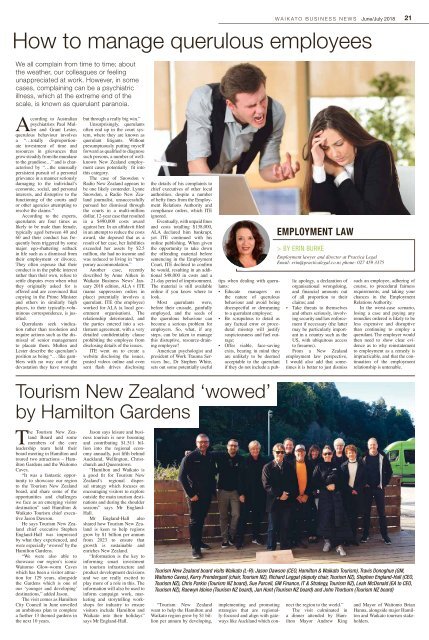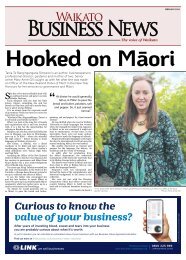Waikato Business News June/July 2018
Waikato Business News has for a quarter of a century been the voice of the region’s business community, a business community with a very real commitment to innovation and an ethos of co-operation.
Waikato Business News has for a quarter of a century been the voice of the region’s business community, a business community with a very real commitment to innovation and an ethos of co-operation.
- No tags were found...
You also want an ePaper? Increase the reach of your titles
YUMPU automatically turns print PDFs into web optimized ePapers that Google loves.
WAIKATO BUSINESS NEWS <strong>June</strong>/<strong>July</strong> <strong>2018</strong> 21<br />
How to manage querulous employees<br />
We all complain from time to time; about<br />
the weather, our colleagues or feeling<br />
unappreciated at work. However, in some<br />
cases, complaining can be a psychiatric<br />
illness, which at the extreme end of the<br />
scale, is known as querulant paranoia.<br />
According to Australian<br />
psychiatrists Paul Mullen<br />
and Grant Lester,<br />
querulous behaviour involves<br />
a “…totally disproportionate<br />
investment of time and<br />
resources in grievances that<br />
grow steadily from the mundane<br />
to the grandiose…” and is characterised<br />
by “…the unusually<br />
persistent pursuit of a personal<br />
grievance in a manner seriously<br />
damaging to the individual’s<br />
economic, social, and personal<br />
interests, and disruptive to the<br />
functioning of the courts and/<br />
or other agencies attempting to<br />
resolve the claims.”<br />
According to the experts,<br />
querulants are four times as<br />
likely to be male than female,<br />
typically aged between 40 and<br />
60 and their conduct has frequently<br />
been triggered by some<br />
major ego-shattering setback<br />
in life such as a dismissal from<br />
their employment or divorce.<br />
They often espouse that their<br />
conduct is in the public interest<br />
rather than their own, refuse to<br />
settle disputes even when what<br />
they originally asked for is<br />
offered and are convinced that<br />
copying in the Prime Minister<br />
and others in similarly high<br />
places, to their typically-voluminous<br />
correspondence, is justified.<br />
Querulants seek vindication<br />
rather than resolution and<br />
require actions such as the dismissal<br />
of senior management<br />
to placate them. Mullen and<br />
Lester describe the querulant’s<br />
position as being “… like gamblers<br />
with no way out of the<br />
devastation they have wrought<br />
but through a really big win.”<br />
Unsurprisingly, querulants<br />
often end up in the court system,<br />
where they are known as<br />
querulant litigants. Without<br />
presumptuously putting myself<br />
forward as qualified to diagnose<br />
such persons, a number of wellknown<br />
New Zealand employment<br />
cases potentially fit into<br />
this category.<br />
The case of Snowdon v<br />
Radio New Zealand appears to<br />
be one likely contender. Lynne<br />
Snowdon, a Radio New Zealand<br />
journalist, unsuccessfully<br />
pursued her dismissal through<br />
the courts in a multi-million<br />
dollar, 12-year case that resulted<br />
in a $490,000 costs award<br />
against her. In an affidavit filed<br />
in an attempt to reduce the costs<br />
award, she deposed that as a<br />
result of her case, her liabilities<br />
exceeded her assets by $2.5<br />
million, she had no income and<br />
was reduced to living in “temporary<br />
accommodation.”<br />
Another case, recently<br />
described by Anne Aitken in<br />
<strong>Waikato</strong> <strong>Business</strong> <strong>News</strong>’ January<br />
<strong>2018</strong> edition, ALA v ITE<br />
(name suppression orders in<br />
place) potentially involves a<br />
querulant. ITE (the employee)<br />
worked for ALA (a local government<br />
organisation). The<br />
relationship deteriorated, and<br />
the parties entered into a settlement<br />
agreement, with a very<br />
detailed confidentiality clause<br />
prohibiting the employee from<br />
disclosing details of the issues.<br />
ITE went on to create a<br />
website disclosing the issues,<br />
posted videos online and even<br />
sent flash drives disclosing<br />
the details of his complaints to<br />
chief executives of other local<br />
authorities, despite a number<br />
of hefty fines from the Employment<br />
Relations Authority and<br />
compliance orders, which ITE<br />
ignored.<br />
Eventually, with unpaid fines<br />
and costs totalling $138,000,<br />
ALA declared him bankrupt,<br />
yet ITE continued with his<br />
online publishing. When given<br />
the opportunity to take down<br />
the offending material before<br />
sentencing in the Employment<br />
Court, ITE declined to confirm<br />
he would, resulting in an additional<br />
$48,000 in costs and a<br />
21-day period of imprisonment.<br />
The material is still available<br />
online if you know where to<br />
look.<br />
Most querulants were,<br />
before their crusade, gainfully<br />
employed, and the seeds of<br />
the querulous behaviour can<br />
become a serious problem for<br />
employers. So, what, if any<br />
steps, can be taken to manage<br />
this disruptive, resource-draining<br />
employee?<br />
American psychologist and<br />
president of Work Trauma Services<br />
Inc, Dr Stephen White,<br />
sets out some potentially useful<br />
EMPLOYMENT LAW<br />
> BY ERIN BURKE<br />
Employment lawyer and director at Practica Legal<br />
Email: erin@practicalegal.co.nz phone: 027 459 3375<br />
tips when dealing with querulants:<br />
• Educate managers on<br />
the nature of querulous<br />
behaviour and avoid being<br />
disrespectful or demeaning<br />
to a querulant employee;<br />
• Be scrupulous to detail as<br />
any factual error or procedural<br />
misstep will justify<br />
suspiciousness and fuel outrage;<br />
• Offer viable, face-saving<br />
exits, bearing in mind they<br />
are unlikely to be deemed<br />
acceptable to the querulant<br />
if they do not include a public<br />
apology, a declaration of<br />
organisational wrongdoing,<br />
and financial amounts out<br />
of all proportion to their<br />
claims; and<br />
• Take threats to themselves<br />
and others seriously, involving<br />
security and law enforcement<br />
if necessary (the latter<br />
may be particularly important<br />
in a country such as the<br />
US, with ubiquitous access<br />
to firearms).<br />
From a New Zealand<br />
employment law perspective,<br />
I would also add that sometimes<br />
it is better to just dismiss<br />
such an employee, adhering of<br />
course, to procedural fairness<br />
requirements, and taking your<br />
chances in the Employment<br />
Relations Authority.<br />
In the worst-case scenario,<br />
losing a case and paying any<br />
remedies ordered is likely to be<br />
less expensive and disruptive<br />
than continuing to employ a<br />
querulant. The employer would<br />
then need to show clear evidence<br />
as to why reinstatement<br />
to employment as a remedy is<br />
impracticable, and that the continuation<br />
of the employment<br />
relationship is untenable.<br />
Tourism New Zealand ‘wowed’<br />
by Hamilton Gardens<br />
The Tourism New Zealand<br />
Board and some<br />
members of the core<br />
leadership team held their<br />
board meeting in Hamilton and<br />
toured two attractions – Hamilton<br />
Gardens and the Waitomo<br />
Caves.<br />
“It was a fantastic opportunity<br />
to showcase our region<br />
to the Tourism New Zealand<br />
board, and share some of the<br />
opportunities and challenges<br />
we face as an emerging visitor<br />
destination” said Hamilton &<br />
<strong>Waikato</strong> Tourism chief executive<br />
Jason Dawson.<br />
He says Tourism New Zealand<br />
chief executive Stephen<br />
England-Hall was impressed<br />
by what they experienced, and<br />
were especially ‘wowed’ by the<br />
Hamilton Gardens.<br />
“We were also able to<br />
showcase our region’s iconic<br />
Waitomo Glow-worm Caves<br />
which has been a visitor attraction<br />
for 129 years, alongside<br />
the Gardens which is one of<br />
our ‘younger and developing’<br />
destinations,” added Jason.<br />
The visit comes as Hamilton<br />
City Council in <strong>June</strong> unveiled<br />
an ambitious plan to complete<br />
a further 13 themed gardens in<br />
the next 10 years.<br />
Jason says leisure and business<br />
tourism is now booming<br />
and contributing $1.511 billion<br />
into the regional economy<br />
annually, just fifth behind<br />
Auckland, Wellington, Christchurch<br />
and Queenstown.<br />
“Hamilton and <strong>Waikato</strong> is<br />
a good fit for Tourism New<br />
Zealand’s regional dispersal<br />
strategy which focuses on<br />
encouraging visitors to explore<br />
outside the main tourism destinations<br />
and during the shoulder<br />
seasons” says Mr England-<br />
Hall.<br />
Mr England-Hall also<br />
shared how Tourism New Zealand<br />
is keen to help regions<br />
grow by $1 billion per annum<br />
from 2023 to ensure that<br />
growth is sustainable and<br />
enriches New Zealand.<br />
“Information is the key to<br />
informing smart investment<br />
in tourism infrastructure and<br />
product development decisions<br />
and we are really excited to<br />
play more of a role in this. The<br />
information will also be used to<br />
inform campaign work, marketing<br />
and storytelling workshops<br />
for industry to ensure<br />
visitors include Hamilton and<br />
<strong>Waikato</strong> into their holidays”<br />
says Mr England-Hall.<br />
Tourism New Zealand board visits <strong>Waikato</strong> (L-R): Jason Dawson (CEO, Hamilton & <strong>Waikato</strong> Tourism), Travis Donoghue (GM,<br />
Waitomo Caves), Kerry Prendergast (chair, Tourism NZ), Richard Leggat (deputy chair, Tourism NZ), Stephen England-Hall (CEO,<br />
Tourism NZ), Chris Parkin (Tourism NZ board), Sue Parcell, GM Finance, IT & Strategy, Tourism NZ), Leah McDonald (EA to CEO,<br />
Tourism NZ), Raewyn Idoine (Tourism NZ board), Jan Hunt (Tourism NZ board) and John Thorburn (Tourism NZ board)<br />
“Tourism New Zealand<br />
want to help the Hamilton and<br />
<strong>Waikato</strong> region grow by $1 billion<br />
per annum by developing,<br />
implementing and promoting<br />
strategies that are regionally-focused<br />
and align with gateways<br />
like Auckland which connect<br />
the region to the world.”<br />
The visit culminated in<br />
a dinner attended by Hamilton<br />
Mayor Andrew King<br />
and Mayor of Waitomo Brian<br />
Hanna, alongside major Hamilton<br />
and <strong>Waikato</strong> tourism stakeholders.


















